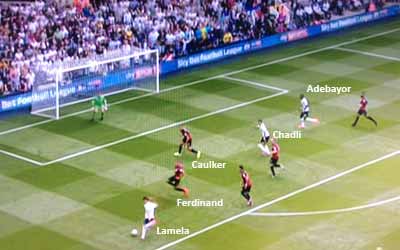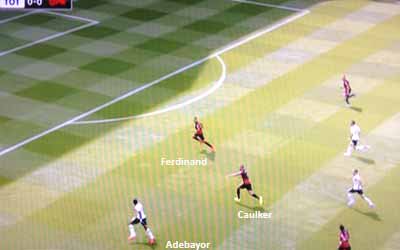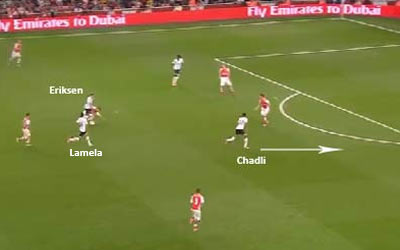Formation fluidity, quicker transitions and better in-game substitutions all need to be addressed by Mauricio Pochettino.
When Mauricio Pochettino took over in the Tottenham hot-seat we saw him try and put his blueprint quickly in to practice.
Maybe he tried to change the setup too rapidly and was having second thoughts? Maybe he didn’t have the personnel to execute them? Whatever the reasons, as the season wore on, we saw him revert away from a number of his tactics that he had tried to install.
After looking at our use of pressing, defence, defensive midfield and set pieces, we now move on to look at fluidity, transition times and Pochettino’s use of in-game substitutions.
Fluidity
Mauricio Pochettino’s main calling card from his successful Southampton team was pressing. After that came fluidity in attack. Players seamlessly switched positions and essentially filled roles to keep the balance of the team. Everyone new what was required in each role and when they found themselves in that position, they could carry out the workload required.
He began to instill this at Spurs. Remember back when Nacer Chadli, Erik Lamela and Christian Eriksen would switch around? We saw this perfectly executed at the start of the season as we tore up QPR 4-0.
It manifested itself beautifully when Lamela started from the right and drifted to the left to set up Nacer Chadli, who had switched in the opposite direction. Both wide players were in-sync and it was a highlight of this fluid system coming to fruition.

As the season wore on, this switching of positions all but disappeared. Inverted wide forwards just drifted in to the middle and congested this area and we bemoaned the lack of width. The obsession with inverted wide forwards who came inside meant that without fluidity, everyone ploughed back in to the centre and we become predictable and easy to stop. This was especially true when players like Andros Townsend were selected, as he would cut in off the right flank and shoot.
The problem was further compounded when Mauricio Pochettino opted for a second striker as a number ten. With Paulinho, Harry Kane or Roberto Soldado filing this position off another centre forward, we had no changing of roles and the formation from a fluidity standpoint was stagnant.
Mauricio Pochettino needs to revisit the fluidity factor this season. It was a trademark of his Southampton side and the unpredictability of just who was going to pop up where was one of the reasons behind it’s success.
Transition times
With Mauricio Pochettino’s patented pressing philosophy, this cut down on transition times from defence to attack.
It was also aided by the fluidity of the formation. When the ball was won back, players were there to fill the role closest to their position. Getting a jump on the opposition in this way opened up greater windows of opportunity to attack much more quickly.
The theory is good, the problem we had last season was that our play became slow with a lot of sideways passing. This was especially true as we became less aggressive in our pressing. This meant that opposition teams could get back in their defensive shape and get set before we could hurt them.
We did see some fleeting examples of quick transitions last season. Our 4-0 win against QPR was full of them. Nabil Bentaleb winning the ball back and then breaking quickly forward, passing it up to Emmanuel Adebayor to set up Nacer Chadli’s opener was one. As Adebayor went left, Chadli had moved inside from his starting position on that flank as the part of the fluid formation to fill the striker’s role.

Ryan Mason pressing and winning the ball back from Fernandinho to tee-up Christian Eriksen at the Etihad was another great example early in the season. The swiftness of regaining the ball to Eriksen rifling it home meant Manchester City had no time to regroup.
The best example of pressing and a quick transition was of course at the Emirates. A series of players closing down started by Younes Kaboul saw Mathieu Flamini stripped of the ball. Kaboul had been caught up the field and immediately filled the wide forward’s role. Christian Eriksen picked it up and rapidly moved it to Nacer Chadli to score. The fluid formation was again at work, as Adebayor had gone left and Chadli immediately filled the centre forward’s position.

The combination of pressing and quick transitions became fewer and further between last season. It’s a part of his philosophy that Mauricio Pochettino must revisit and something that he needs to work on with the players on the training field. Transitions can be from counter attacks or pressing high up, but the speed has gone out of our game and it needs to return.
Mauricio Pochettino Substitutions
Even the best preparations for a match can see the team failing to make an impact or struggling to break the opposition down. This is when a coach has to take stock and use the options available to him on his bench in order to influence a game.
Mauricio Pochettino has his Plan A, but having something else up his sleeve was a criticism that followed him throughout last season. The problem for Pochettino was that his in-game use of his substitutes bench has been more miss than hit.
The most stunning example was Manchester United 3-0 Spurs at Old Trafford. The Red Devils were beating us up and raced in to a 2-0 lead. Mauricio Pochettino had got his initial setup wrong. Then he failed to make the necessary changes both tactically and from his substitutes bench until it was too late.
In going down 2-0, our head coach made a move after 31 minutes, bringing on Mousa Dembele for Andros Townsend. Mauricio Pochettino did have to be commended for making a change relatively early, not many managers make tactical substitutions in the first half. However, Man Utd were hammering us down our right, as they went after the inexperienced and errant defensive positioning down this side.
By introducing Dembele, Mauricio Pochettino had brought some size and a pressing presence in to the number ten position to help shield Mason and Bentaleb. This did something, but didn’t address the main issue to stem the flow of Man Utd attacks down our right. The reason being that the change sent Nacer Chadli over to this flank, who, like Townsend, wasn’t reliable enough to track and help his full back. The move ended up solving next to nothing.
It wasn’t until Mauricio Pochettino switched Nabil Bentaleb on to marking Fellaini at half time that we started to slow Man Utd down. Of course, by then we were 3-0 down and the horse had well and truly bolted.
This was a tactical move, but the substitution that should’ve occurred in the first half – bringing on a better defensive wide forward in Erik Lamela to plug the right side – happened far too late. 64 minutes were on the clock when this switch came, only after which we began to gain a slight attacking foothold in the match.
Man Utd were managing the game by this point, but seeing us begin to push them back, Pochettino then sent on Emmanuel Adebayor for Nacer Chadli. The problem with this switch was that we needed a player who could run in-behind the Man Utd defence. Erik Lamela sending Harry Kane through and David de Gea foiling our striker as he tried to send the ball through his legs highlighted this.
Adebayor, however, is a player that comes towards the ball. Removing Chadli, a player that likes to run in-behind for one who comes short, again did nothing to affect the game.
Mauricio Pochettino had made three changes and only one of them, Erik Lamela, had a positive impact on altering the flow of the game. It is this 1 in 3 ratio that seems to be Pochettino’s hit rate when it comes to making good substitutions.
Tactical issues Mauricio Pochettino must address
Fluidity, transition times and better in-game substitutions all need to be addressed by Mauricio Pochettino if we are to make progress this season.
It sometimes seems that in chasing a game his judgment can become clouded. More so than when we are ahead and he is looking to constrict the opposition by continuing with his original game plan. Haphazard changes can cause fans to level at him that he doesn’t have a Plan B, when actually he’s just been slow to recognise where the moves need to be made.
This is all a learning curve for what is still a relatively young coach. Mauricio Pochettino is just 43 years old and continues to gain knowledge of how his changes can affect a game during the match. Setting his team up is the easier part of any game plan, changing it mid-match when things aren’t going as expected is where the best earn their money.
